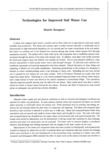Technologies for Improved Soil Water Use
JIRCAS international symposium series
| ISSN | 13406108 |
|---|---|
| 書誌レコードID(総合目録DB) | AA1100908X |

本文フルテキスト
intlsymp-10_45-52.pdf289.89 KB
A dense and compact layer below a surface soil is often observed in agricultural soils and causes unstable crop production. The dense and compact layer is either formed naturally or artificially and is characterized by high mechanical impedance for root growth and low water transmission in the soil matrix. Soil water in a surface soil is not drained but remains during rain events unless bypass flow through macropores occurred. The surface soil is easily dried up by soil evaporation due to insufficient upward water movement through the matrix of the dense and compact layer. In addition, most plant roots hardly penetrate the dense and compact layer and shallow root systems are formed. Due to such physical conditions, crops become susceptible to both excess water injury and drought damage. To alleviate such adverse soil conditions, agronomic and physical approaches have been adopted. Subsoil disruption by deep tillage and subsoiling is effective for soil profile modification: Subsoiling perpendicular to the envelope of a drainpipe is effective to collect residual ponding water to the drainpipe in clayey soils. Subsoiling has also been carried out to expand the soil volume for root water uptake. Soils in Northeast Thailand are sandy soils with impervious dense layers. Subsoiling in a wet season promoted deep percolation and reduced water erosion, and a large amount of water was stored in the subsoil compared to conventional tillage. This resulted in vigorous sugarcane growth starting near the end of the wet season. Deep rooted plants were able to extract stored soil water in deeper layers during the dry season. However, the effect of biopores by deep rooted plants on subsequent crop growth has not been elucidated.
| 作成者 | Shuichi Hasegawa |
|---|---|
| 公開者 | Japan International Research Center for Agricultural Sciences |
| オンライン掲載日 | |
| 号 | 10 |
| 開始ページ | 45 |
| 終了ページ | 52 |
| 言語 | eng |
